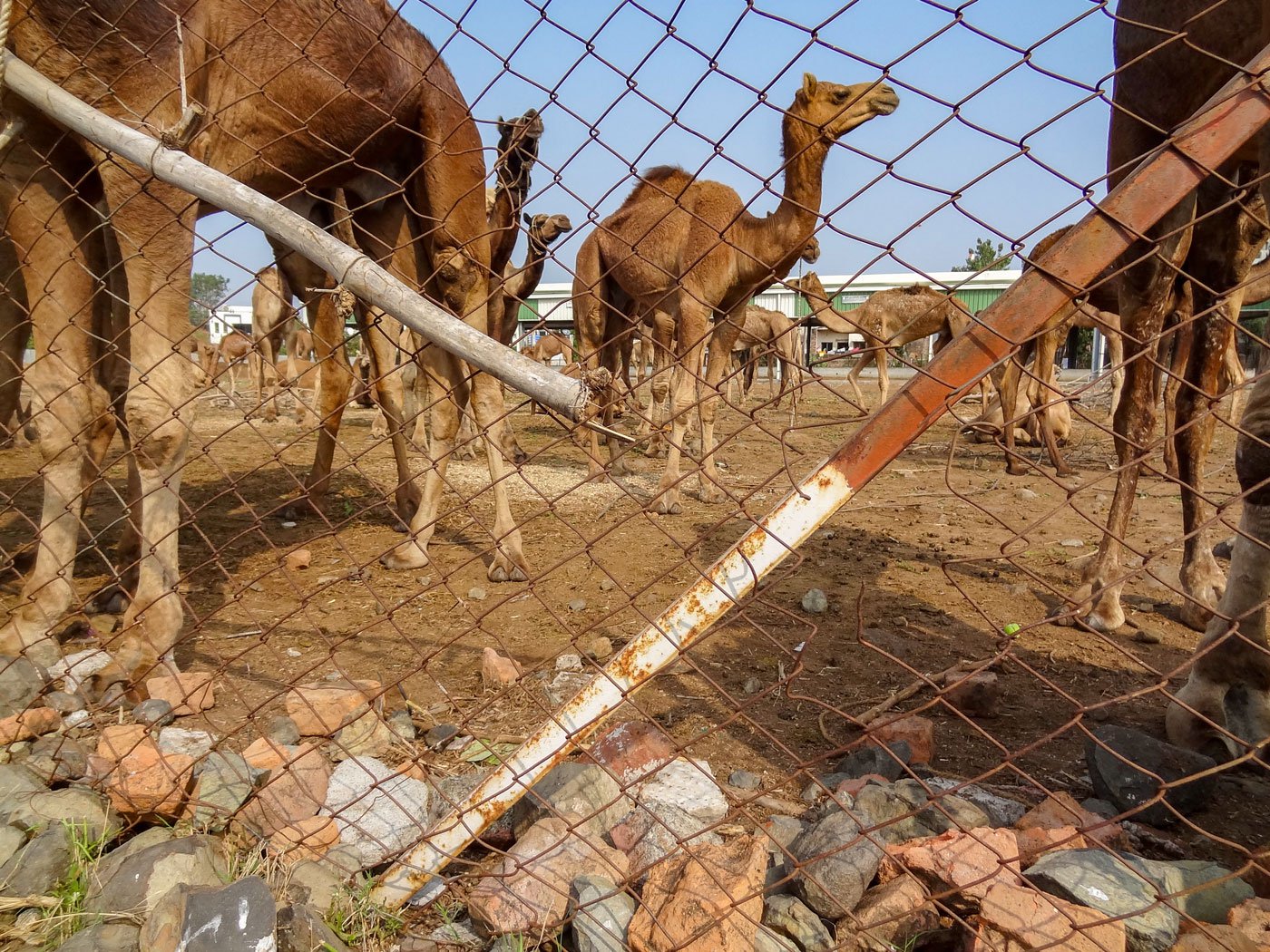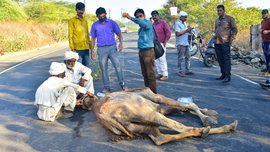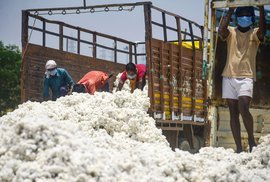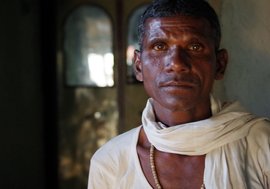“We have not confiscated these 58 camels,” asserts Inspector Ajay Akare, in charge of the Talegaon Dashasar police station in Amravati district. “We don’t have the powers to do so since Maharashtra has no specific law against cruelty to these animals.”
“The camels,” he says, “are under detention.”
And so too would their caretakers be, but for a local judicial magistrate in Amravati. The five keepers are semi-nomadic pastoralists, four from the Rabari community and one a Fakirani Jat, from Kachchh in Gujarat. Both social groups have been traditional camel herders across generations and centuries. The magistrate granted the five immediate and unconditional bail after they were arrested by the police on a complaint from self-styled ‘animal rights activists.’
“The accused did not have any papers pertaining to the purchase and possession of camels or legal documents relating to their own domicile,” says Akare. So, this was followed by the curious situation of traditional herders having to produce ID cards for the camels and their ownership documents for a court. Those were sent in by their relatives and other members of the two semi-nomadic pastoralist groups.
Separated from their herders, the camels now languish in a gauraksha kendra , a shelter home for cows, in the custody of people quite clueless when it comes to caring for and feeding them. While both are ruminants, camels and cows have very different diets. And the condition of the dromedaries is likely to swiftly deteriorate in the cow shelter if the case drags on.
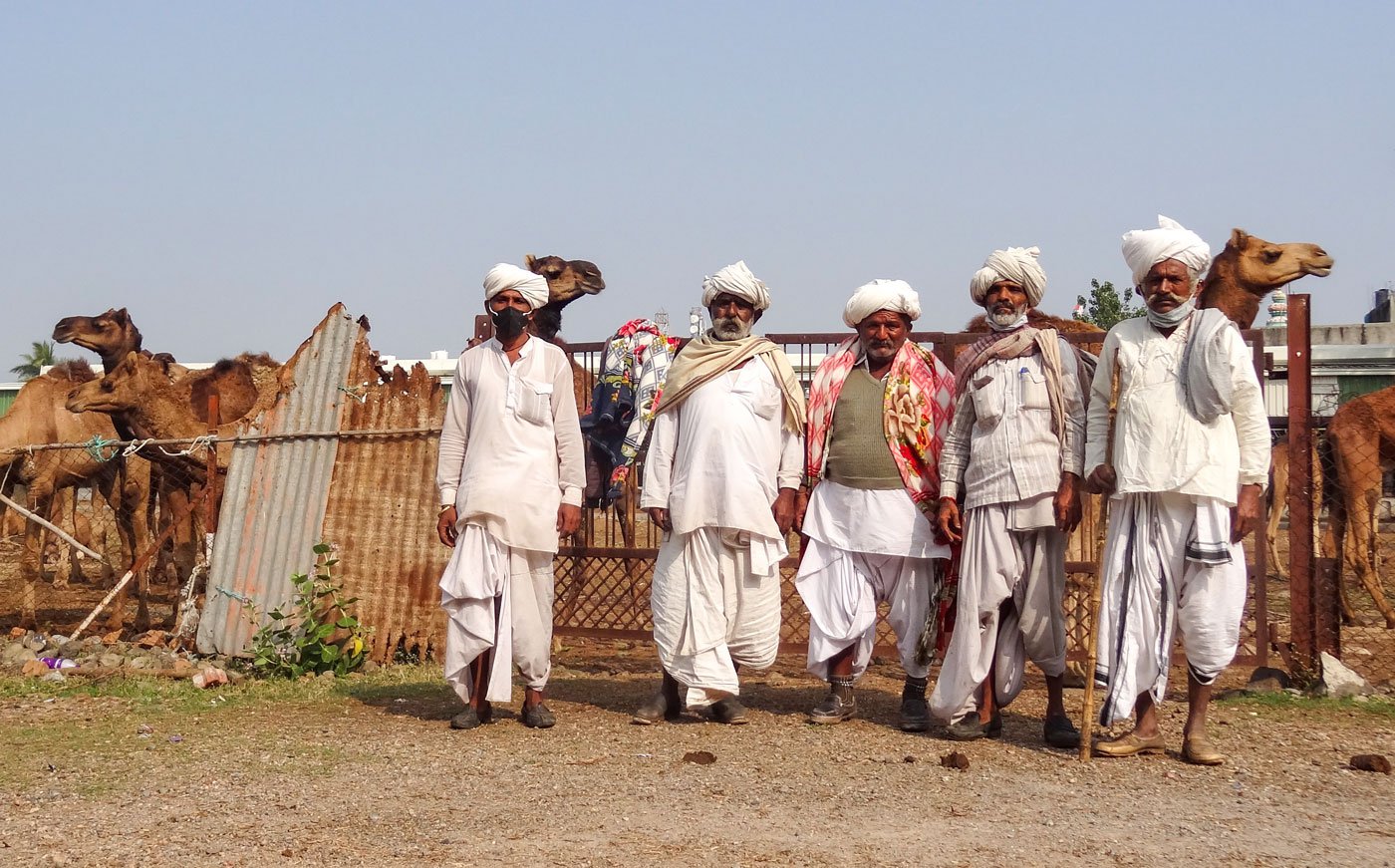
Rabari pastoralists camping in Amravati to help secure the release of the detained camels and their herders
*****
The camel is Rajasthan’s state animal and can’t acclimatise in other states.
Jasraj Shrishrimal, Bharatiya Prani Mitra Sangh, Hyderabad
It all began with deep suspicion.
On January 7, 2022, Hyderabad-based animal welfare activist Jasraj Shrishrimal, 71, filed a complaint with the Talegaon Dashasar police that five herders were allegedly smuggling camels to slaughterhouses in Hyderabad. The police immediately detained the men and their camels. Shrishrimal, though, encountered the herders in Maharashtra’s Vidarbha region, not in Hyderabad.
“I left for Amravati along with a colleague and reached Nimgavhan village [in Chandur Railway tehsil ] where four or five people were camping with camels on a field. On counting we found there were 58 camels – and they had been tied in their necks and legs, due to which they were unable to walk properly, thus treating them cruelly. Some of them had injuries for which the herders had not applied any medicines. The camel is Rajasthan’s state animal and can’t acclimatise in other states. The men had no documents and could not clarify where they were taking the camels,” Shrishrimal’s complaint reads.
Actually, camels in India can be found in Rajasthan, Gujarat and Haryana, and can be encountered in a few other places. However, their breeding is restricted to Rajasthan and Gujarat. The total camel population in the country is just 250,000 according to the 20th Livestock Census – 2019 . That’s a fall of 37 per cent from their numbers in the livestock census of 2012.
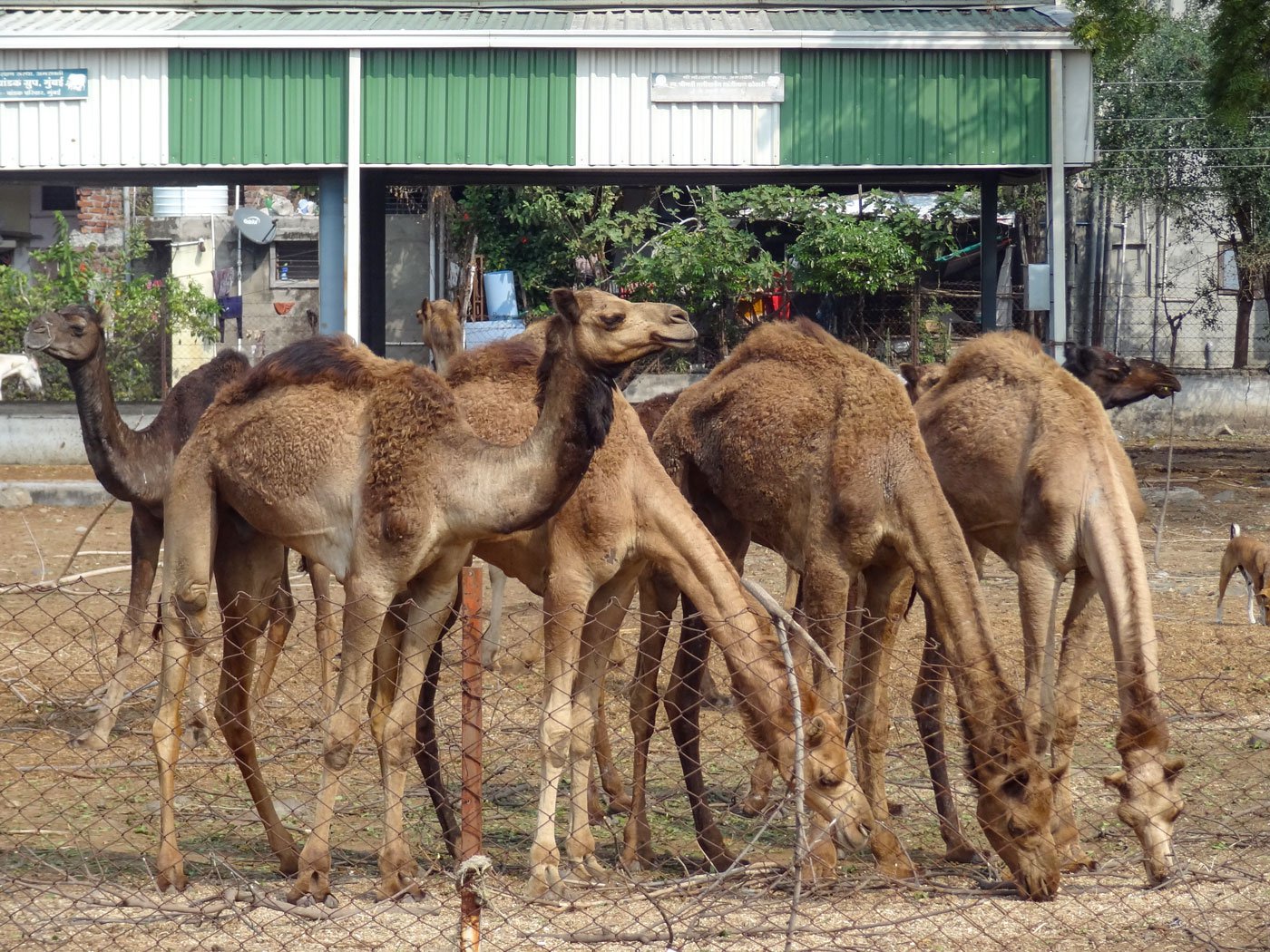
The camels, all male and between two and five years in age, are in the custody of a cow shelter in Amravati city
These five men are experienced herders with expertise in transportation of the large animals. All five are from Kachchh. They have never been to Hyderabad.
“I got no clear answers from the men, which aroused my suspicion,” Shrishrimal told PARI over telephone from Hyderabad. “The cases of illegal camel slaughter are on the rise,” he says, claiming that his organisation – Bharatiya Prani Mitra Sangh – had rescued over 600 camels in five years from across India.
He claims these rescues were effected in Gulbarga, Bengaluru, Akola and Hyderabad among other places. And that his organisation had ‘deported’ the ‘rescued’ animals to Rajasthan. Hyderabad, among other centres across India, he says, has seen a growing demand for camel meat. But researchers and traders say only old male camels are sold for slaughter.
Shrishrimal is closely associated with Bharatiya Janata Party MP and former union minister Maneka Gandhi, who leads the People for Animals organisation. Gandhi was quoted in the Times of India as saying , “there is a large racket and the syndicate is run from Baghpat in Uttar Pradesh. The camels are also taken to Bangladesh. There is no question of having so many camels together.”
After a preliminary inquiry, the police lodged a First Information Report on January 8. Since there is no specific law for camel protection in Maharashtra, the police filed a case under section 11 (1)(d) of Prevention of Cruelty to Animals Act, 1960 .
And charges were slapped on Prabhu Rana, Jaga Hira, Musabhai Hamid Jat, all in their 40s; Visabhai Saravu, in his 50s; and Versibhai Rana Rabari, who is in his 70s.
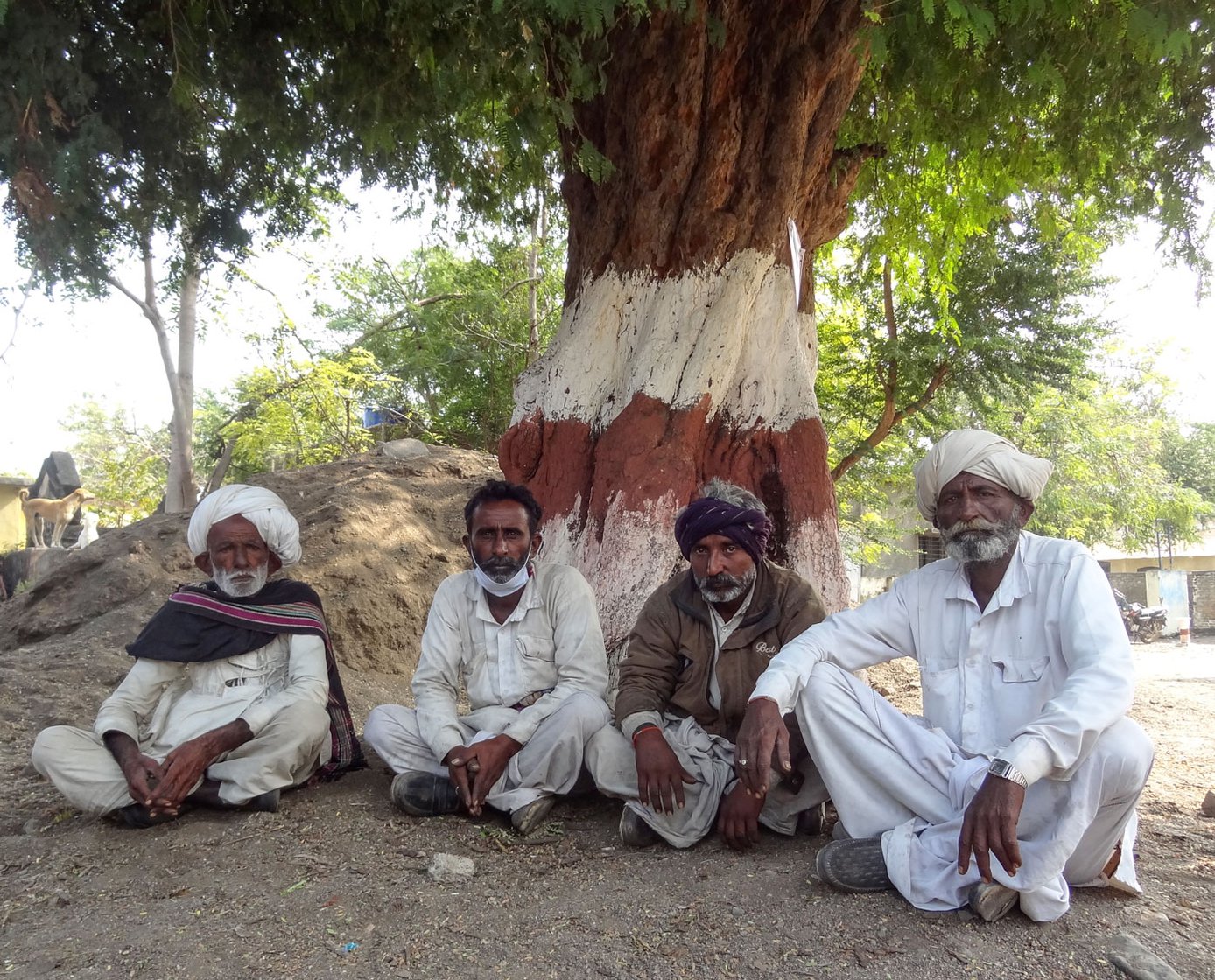
Four of the traditional herders from Kachchh – Versibhai Rana Rabari, Prabhu Rana Rabari, Visabhai
Saravu Rabari and Jaga Hira Rabari (from left to right) – who were arrested along with Musabhai Hamid Jat on January 14 and then released on bail
Tending to the 58 camels, says Inspector Akare, was a real challenge. For two nights, the police took the help of a nearby small gauraksha kendra while approaching the bigger ones in Amravati. The kendra in Amravati’s Dastur Nagar locality volunteered, and the camels were eventually sent there, since they had enough space to keep them.
Ironically, the task of transporting them fell to relatives and acquaintances of the accused, who walked the animals 55 kilometres from Talegaon Dashasar to Amravati city over two days.
Support is pouring in for the herders. At least three gram panchayats in Kachchh have sent in pleas to the Amravati police and district authorities to release the camels for open grazing, failing which they could starve. The Makardhokada gram panchayat in Nagpur district, where the Rabaris have a big dera (settlement), has also endorsed the position of the community that these were traditional herders and that the camels were not headed to a slaughterhouse in Hyderabad. A lower court will decide on their custody: should they be given back to the accused who brought them here, or sent back to Kachchh?
The final outcome depends on whether or not the court believes these men to be traditional keepers of camels.
*****
Our ignorance leads to suspicion towards these traditional herders because they don’t look or speak like us
.
Sajal Kulkarni, researcher on pastoralist communities, Nagpur
All his life, Versibhai Rana Rabari, the oldest of the five herders, has roamed large swathes of the country on foot along with his camels and flocks of sheep, but has never been accused of cruelty to animals.
“This is the first time,” says the wrinkled-faced old man, speaking in the Kachchhi language. He’s squatting beneath a tree in the police station with folded legs – worried and embarrassed.
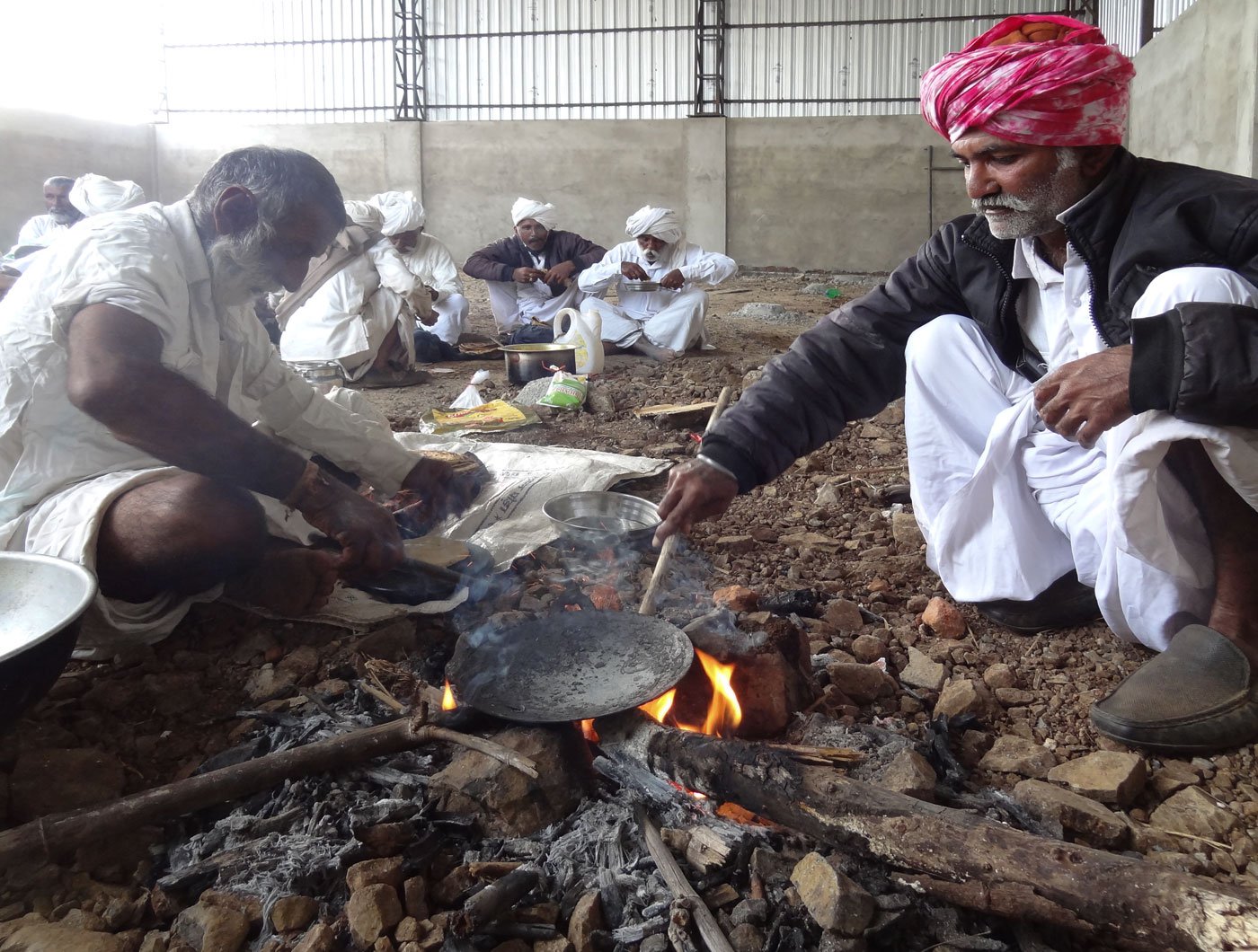
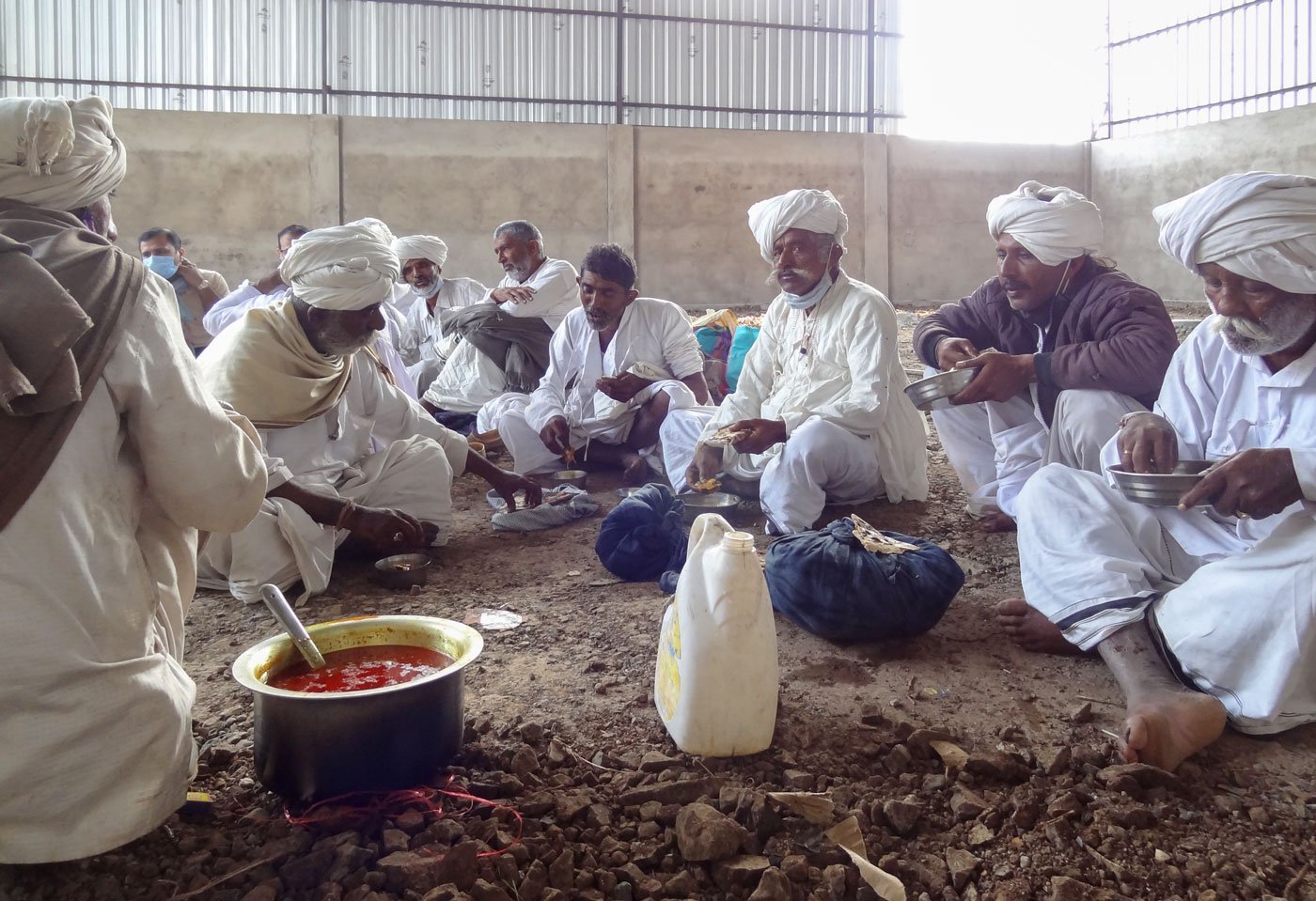
Rabaris from Chhattisgarh and other places have been camping in an open shed at the
gauraksha kendra
in Amravati while waiting for the camels to be freed
“We brought these camels from Kachchh,” Prabhu Rana Rabari, one of the five accused, told us in the Talegaon Dashasar police station on January 13, “to deliver them to our kinsmen living in Maharashtra and Chhattisgarh.” That was a day before they were formally arrested on January 14 and released on bail.
No one stopped them along the route – from Bhuj, in Kachchh, to Amravati. No one suspected them of any wrongdoing. Their epic journey came to an abrupt halt with this unthinkable twist.
The animals were to be delivered at Wardha, Nagpur, Bhandara (in Maharashtra), and also to Rabari settlements in Chhattisgarh.
The Rabari are a semi-nomadic pastoralist community that along with two or three other groups in Kachchh and Rajasthan, rear sheep and goats for their livelihoods and breed camels for use in farm work and transportation. And do so within an established ‘ biocultural community protocol ’ documented by the Kachchh Camel Breeders Association.
A section within the community, the Dhebaria Rabari, migrate long distances for most of the year to places with water-fodder abundance; many families now live in settlements, or deras , across central India for much of the year. Some of them migrate seasonally, after Diwali, and walk to places as far off from Kachchh as Telangana, Andhra Pradesh, Odisha, Chhattisgarh, Madhya Pradesh and the Vidarbha region.
There are at least 3,000 settlements of Dhebaria Rabaris in central India, says Sajal Kulkarni, a Nagpur-based researcher of pastoralists and traditional livestock keepers. Kulkarni, who is a fellow with the Revitalising Rainfed Agriculture Network (RRAN), says one dera could have a cluster of 5-10 families, camels, and large herds of sheep and goats that the Rabaris rear for meat.
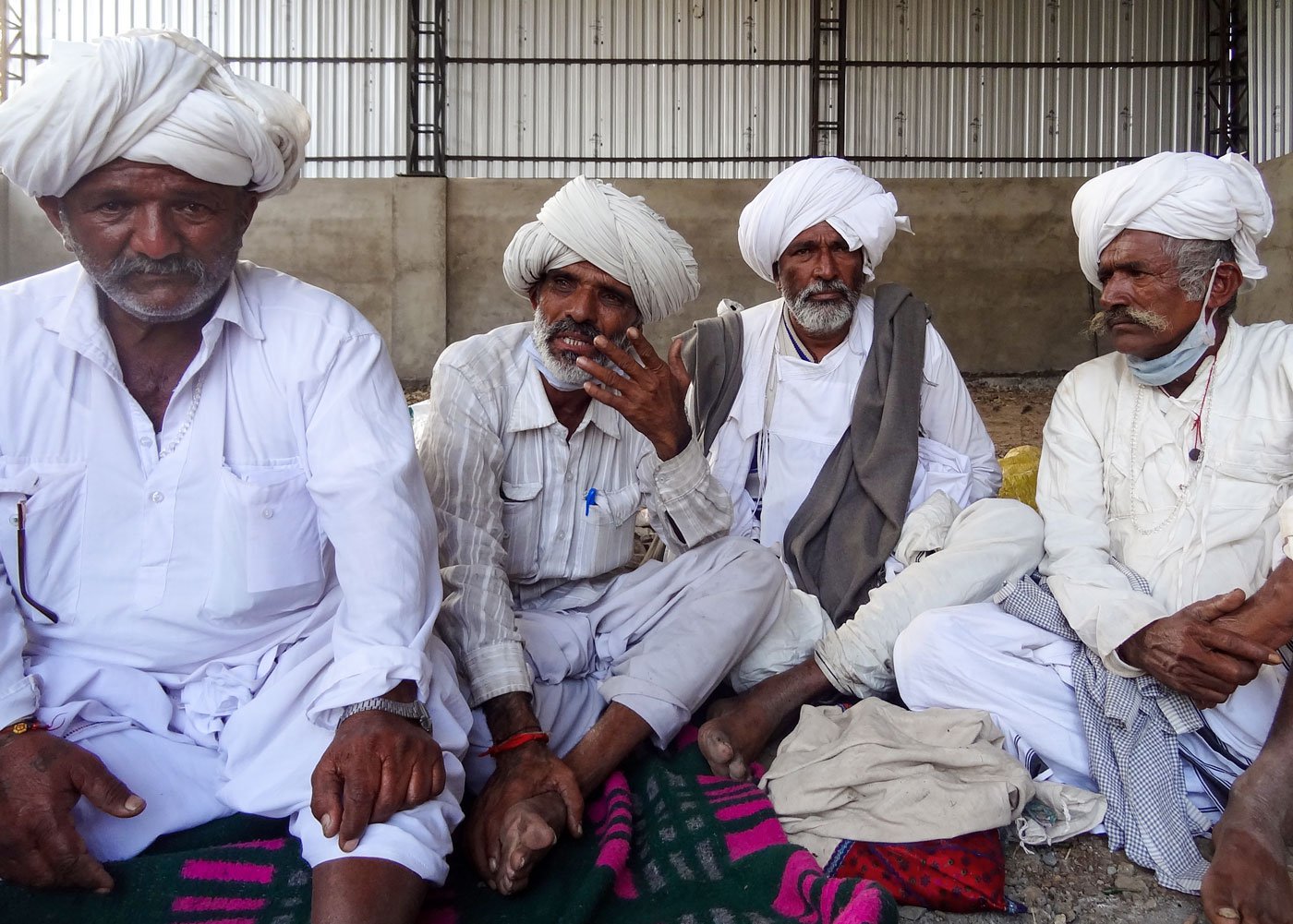
Jakara Rabari and Parbat Rabari (first two from the left), expert herders from Umred in Nagpur district, with their kinsmen in Amravati.They rushed there when they heard about the Kachchhi camels being taken into custody
Kulkarni has been studying pastoralists, including the Rabaris and their livestock cultures, for over a decade. “This incident,” he says about their arrest and the ‘detention’ of the camels, “signifies a lack of understanding about pastoralists. Our ignorance leads to suspicion towards these traditional herders because they don’t look or speak like us.”
Increasingly though, says Kulkarni, some groups of Rabaris are settling down. In Gujarat they are moving away from their traditional work, seeking formal education, and taking up jobs. Quite a few families in Maharashtra now own land here and work closely with local farmers.
“There is a symbiotic relationship between them and farmers,” says Kulkarni. For instance the ‘penning’ – a process whereby the Rabaris keep their sheep and goat herds grazing on farmlands during off-agriculture seasons. This in turn helps enrich soils with animal droppings that act as organic manure. “Farmers who know and share such bonds with them, know their worth,” he says.
The Rabaris who were to receive these 58 camels are located in Maharashtra or Chhattisgarh. They have been living in settlements in these states for almost all their lives, but maintain close links with their kinsmen in Kachchh. Fakirani Jats, on the other hand, do not migrate long distances but are excellent camel breeders, and share cultural bonds with the Rabaris.
According to the NGO Sahjeevan, which runs the Centre for Pastoralism in Bhuj, there are about 500 camel breeders from all pastoralist communities of Kachchh, including the Rabari, Sama and Jat.
“We have verified, and it’s true, that these 58 young camels were bought from 11 breeder-members of the K achchh Unt Uchherak Maldhari Sangathan [Kachchh Camel Breeders Association] – and were meant for their relatives in central India,” Sahjeevan’s programme director Ramesh Bhatti told PARI over phone from Bhuj.
The five men are also astute camel trainers, which is why they were chosen to accompany the animals on this long, arduous, journey, Bhatti tells us. Versibhai is probably among the oldest of active expert trainers and transporters in Kachchh.
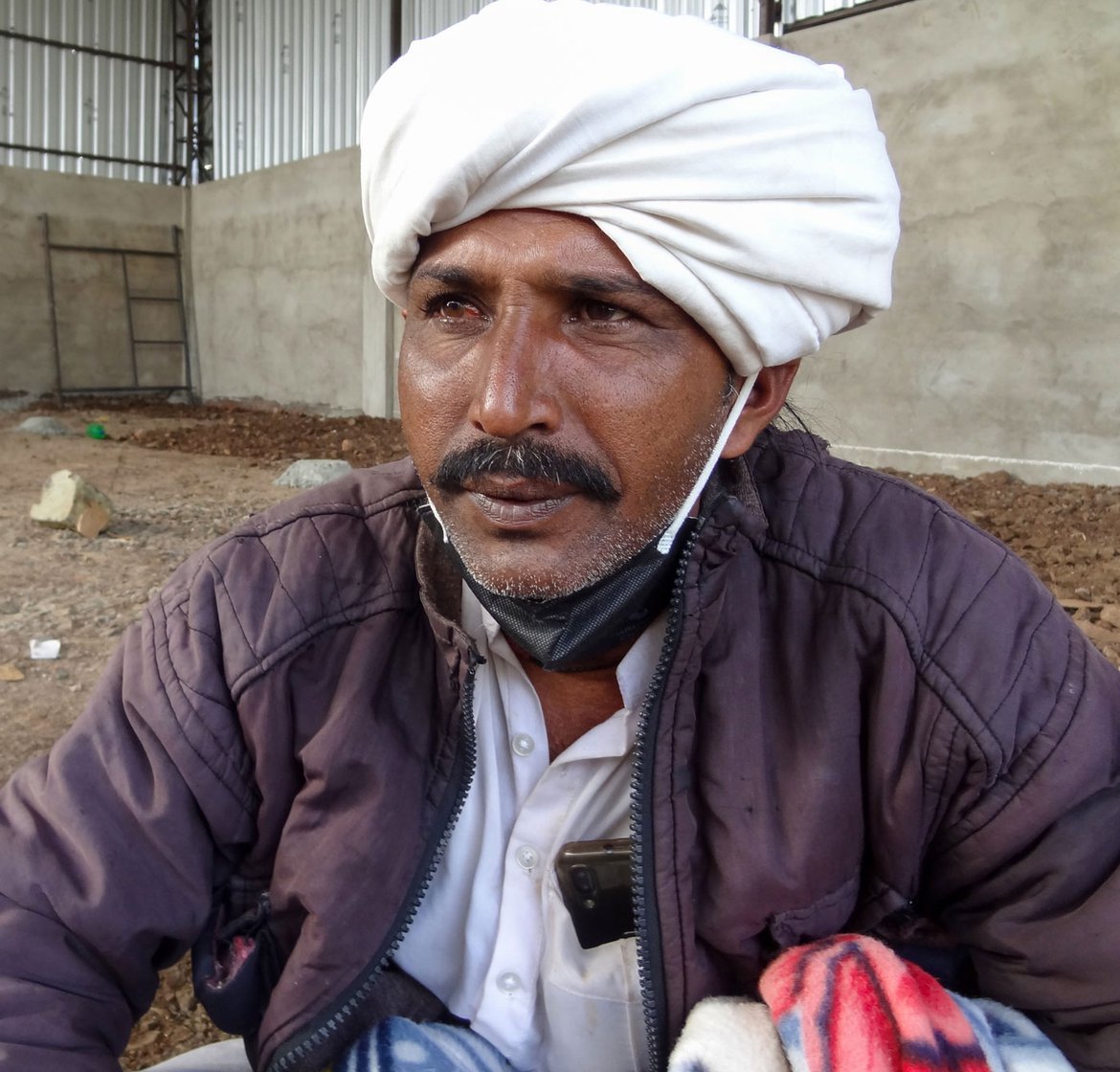
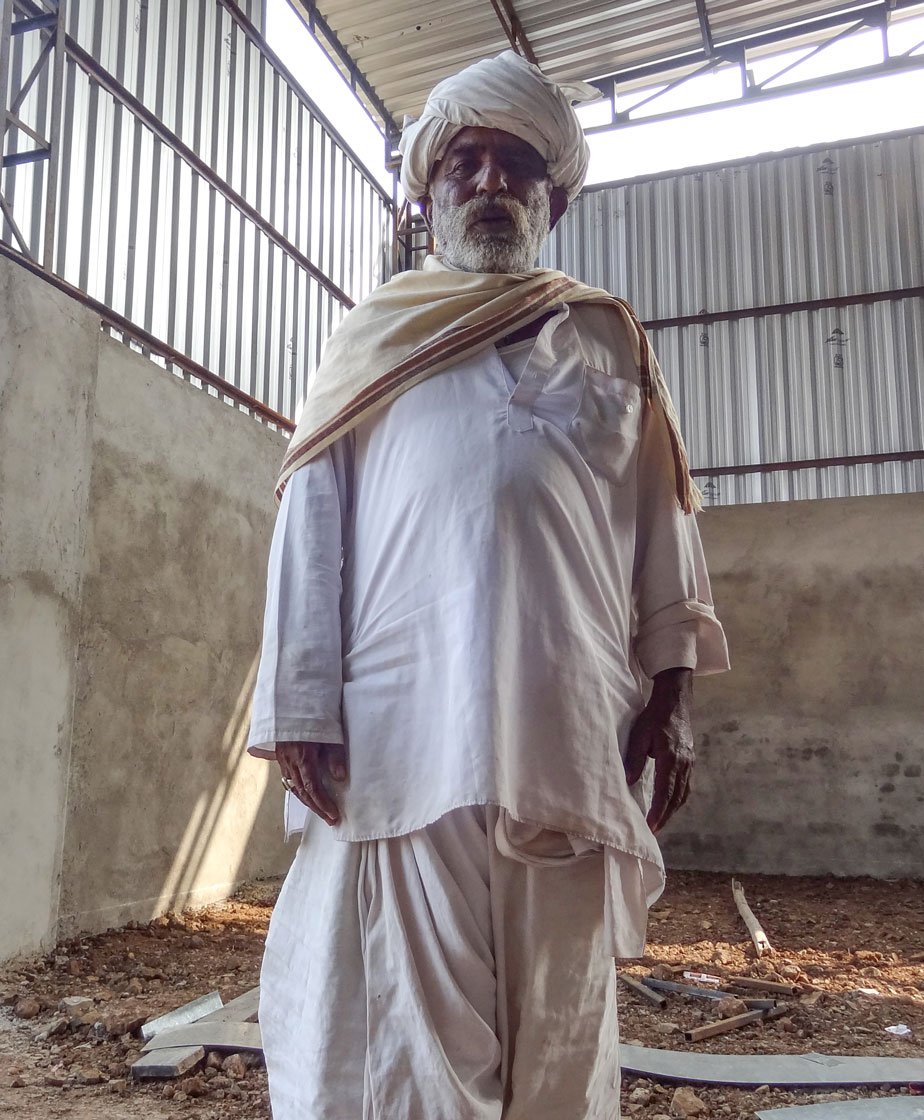
Suja Rabari from Chandrapur district (left) and Sajan Rana Rabari from Gadchiroli district (right) were to receive two camels each
*****
We are a nomadic community; many a time we don’t possess documents…
Mashrubhai Rabari, community leader from Wardha
They don’t remember the exact date on which they started from Kachchh.
“We began collecting the animals from our breeders from different places in the ninth month [September 2021] and started our walk from Bhachau [a tehsil in Kachchh] immediately after Diwali [early November],” a dishevelled and harassed Prabhu Rana Rabari says. “We would have reached Bilaspur, Chhattisgarh – our destination – in mid or late February this year.”
The five men had covered nearly 1,200 kilometres from their native Kachchh on the day they were detained. From Bhachau, they travelled via Ahmedabad and then across Nandurbar, Bhusawal, Akola, Karanja and Talegaon Dashasar – all in Maharashtra. They would have headed for Wardha, Nagpur, Bhandara (also in Maharashtra), and then moved onwards to Durg and Raipur to reach Bilaspur (all three in Chhattisgarh). They had even walked along the newly constructed Samruddhi Highway after touching Karanja town in Washim district.
“We had been walking 12-15 kilometres a day, although a young camel can easily do 20,” notes Musabhai Hamid Jat, perhaps the youngest of the five men. “We would halt at night and start again early morning.” They’d cook for themselves, take an afternoon siesta, allow the camels to rest, and start again.
They’re horrified at having been arrested for simply herding camels.
“We never sell our female camels, and use our male camels for transportation,” Mashrubhai Rabari, a veteran community leader who lives in Wardha district, told us. “Camels are our feet.” All the 58 camels now in ‘detention’ are male.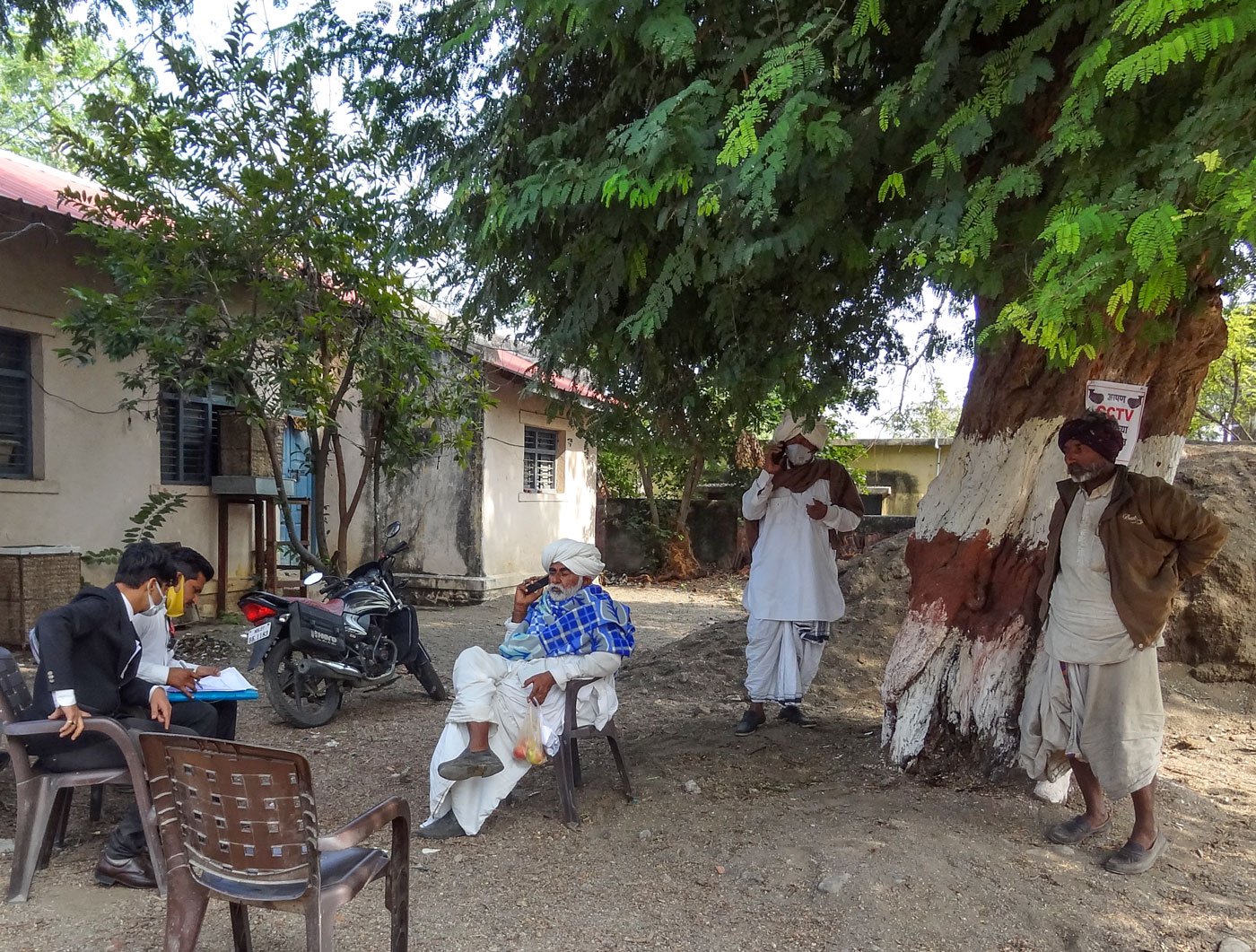
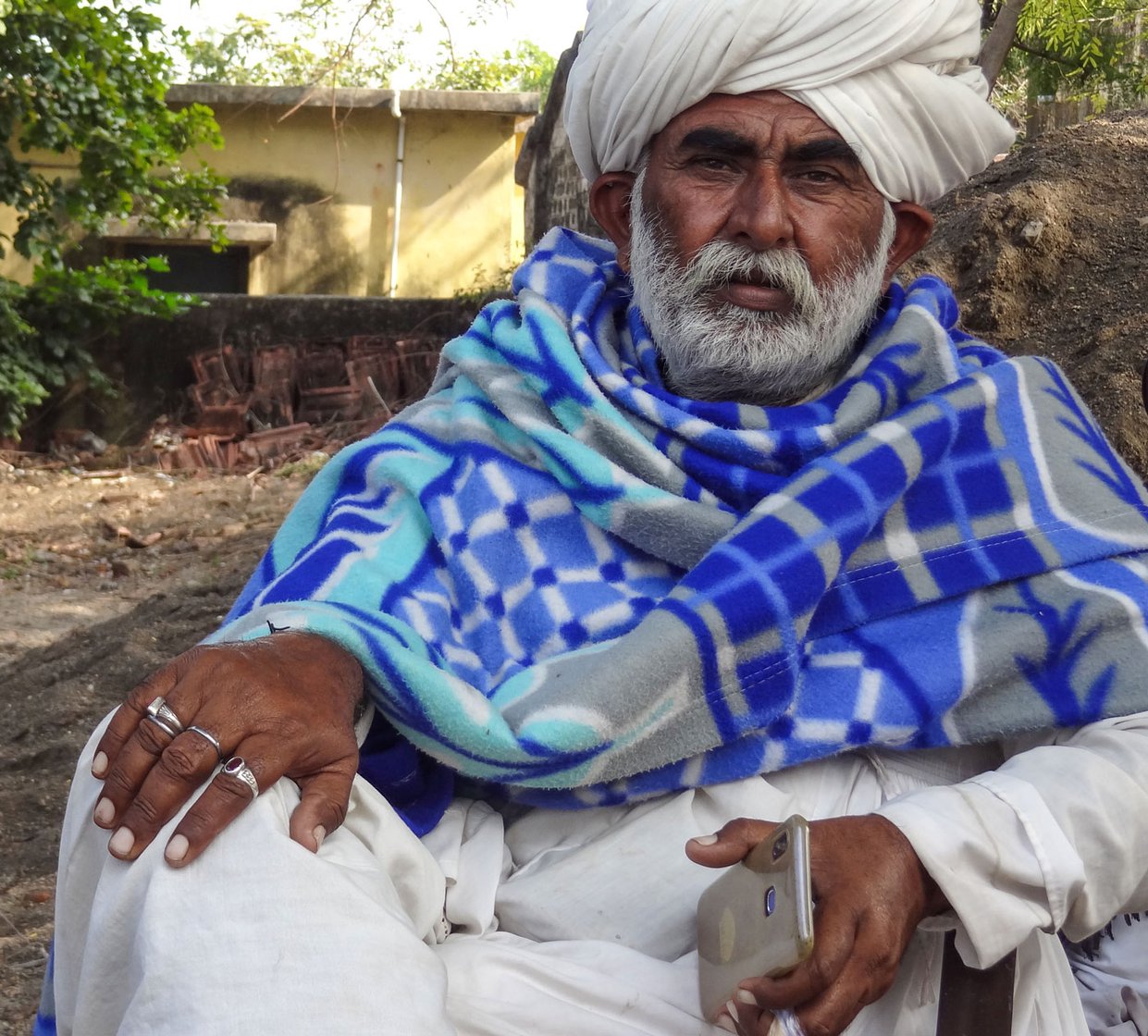
Mashrubhai Rabari (right) has been coordinating between the lawyers, police and family members of the arrested Kachchhi herders. A community leader from Wardha, Mashrubhai
is a crucial link between the Rabari communities scattered across Vidarbha
‘Mashru mama’ , as he is fondly called, has been camping with the five herders since the day they were held by the police. He has been coordinating with their family members, arranging for lawyers in Amravati, helping the police with translations and with the recording of their statements. He is fluent in both Marathi and Kachchhi and is a crucial link between all the scattered settlements of Rabaris here.
“These camels were meant to be delivered to 15-16 of our people living in different deras in Vidarbha, Telangana and Chhattisgarh,” says Mashrubhai. “Each of them was to receive 3-4 camels.” When on the move, the Rabaris load the animals with their belongings, small children, sometimes the sheep calves – virtually their entire world. Never do they use bullock carts like the Dhangar, a shepherd community in Maharashtra, might do.
“We buy these camels from our own breeders back home,” Mashrubhai says. “Whenever 10-15 people are in need of young male camels here to replace the older animals, we place our orders with our relatives in Kachchh. The breeders then send them in one big lot, along with trained men to whom the buyers pay wages for delivering the camels – between 6,000 and 7,000 rupees a month if the journey is of a long duration. A young camel costs between 10,000 and 20,000 rupees Mashrubhai tells us. A camel starts working at the age of 3 and lives up to 20-22 years of age. “A male camel’s working life is 15 years,” he says.
“It’s true these men had no documents with them,” admits Mashrubhai. “We never needed them earlier. But clearly we will need to be careful in the future. Circumstances are changing.”
This complaint, he grumbles, put them and their camels through a lot of needless trouble. “Ami ghumantu samaj aahe, amchya baryach lokay kad kadhi kadhi kagad patra naste,” he says in Marathi. “We are a nomadic community; many a time we don’t possess documents [which was the case here].”
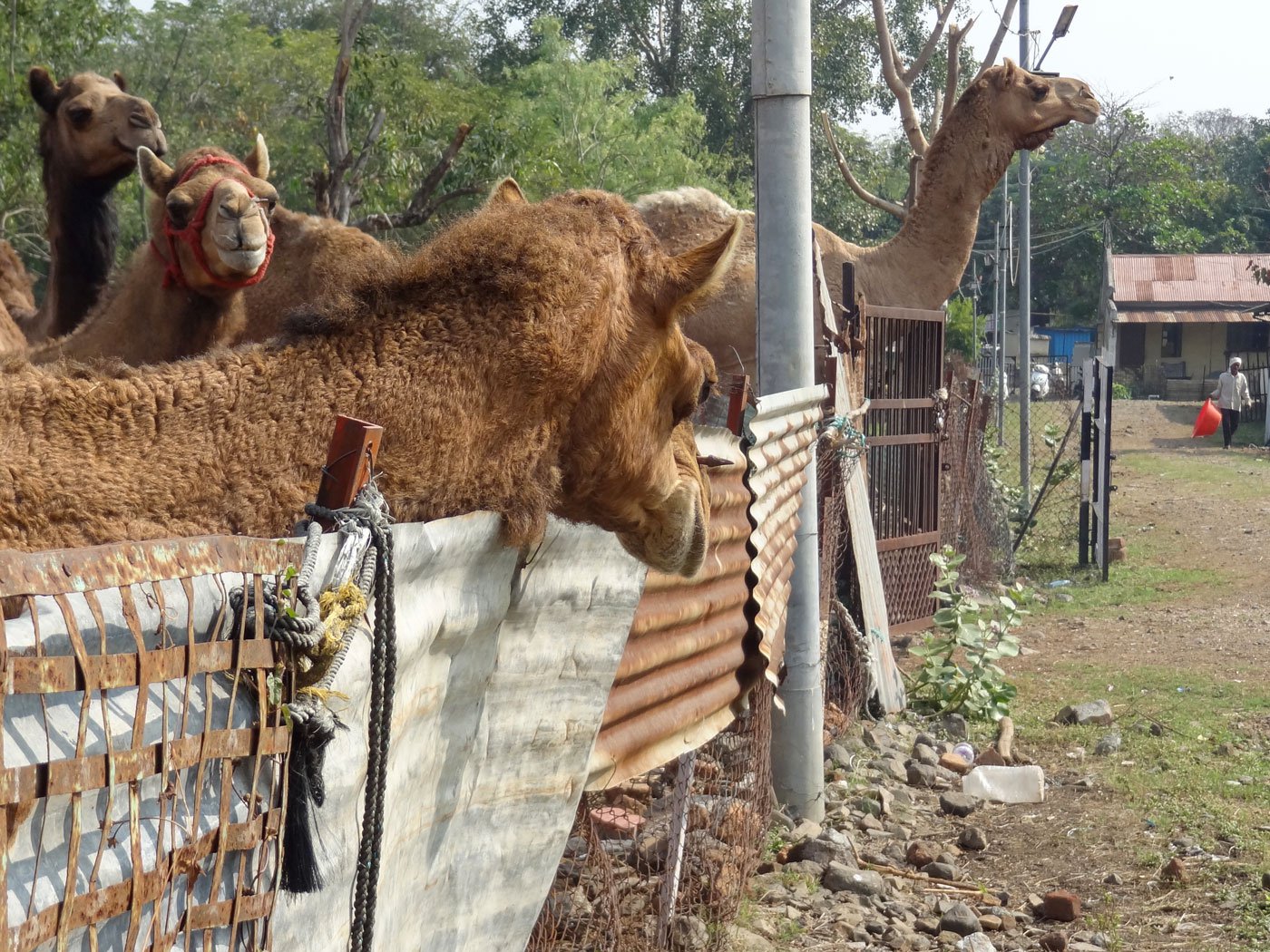
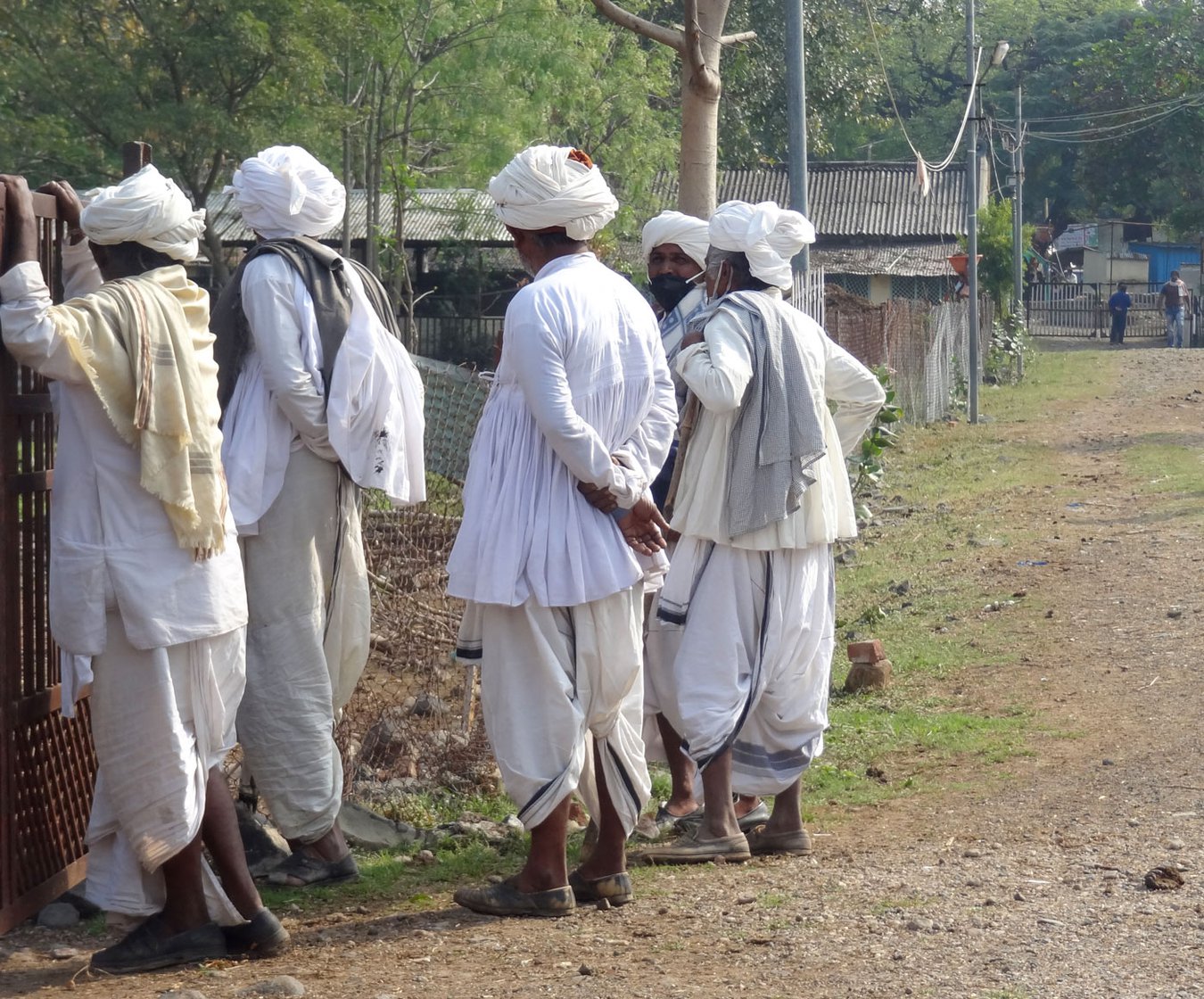
Separated from their herders, the animals now languish in the cow shelter, in the custody of people quite clueless when it comes to caring for and feeding them
*****
The charge against us is that we treated them cruelly. But there is no greater cruelty than keeping them confined here when they need open grazing.
Parbat Rabari, veteran camel keeper from Nagpur
The camels in detention are all young males between two and five years of age. They are of the Kachchhi breed, typically found in the inland terrestrial ecosystems of Kachchh. There are an estimated 8,000 such camels in Kachchh today.
Males of this breed typically weigh 400 to 600 kilos while females weigh between 300 and 540 kilos. The World Atlas notes that the narrow chest, single hump, long, curved neck, and long hairs on hump, shoulders, and throat are the important characteristic features of the camel. The coat colour ranges from brown to black to even white.
Brownish in colour, these Kachchhi ungulates love open grazing and feed on a vast variety of plant and leaf species. They can feed on leaves that could be from trees in forests, or even on pastures, or farmlands lying fallow.
Rearing camels has become increasingly difficult in Rajasthan and Gujarat. In both states, the last decade or two have seen more than a few curbs on entry into forests and mangrove swamps. The nature of development in their areas has also added to the problems of camels and their breeders and owners. The animals have thus lost access to free fodder that was earlier available aplenty.
The five men, now out on bail, have joined their kinsmen at the cattle shelter in Amravati where their camels are currently kept in the open in a large ground – fenced all around. The Rabaris are worried about their well-being because they are not getting the fodder they are used to.
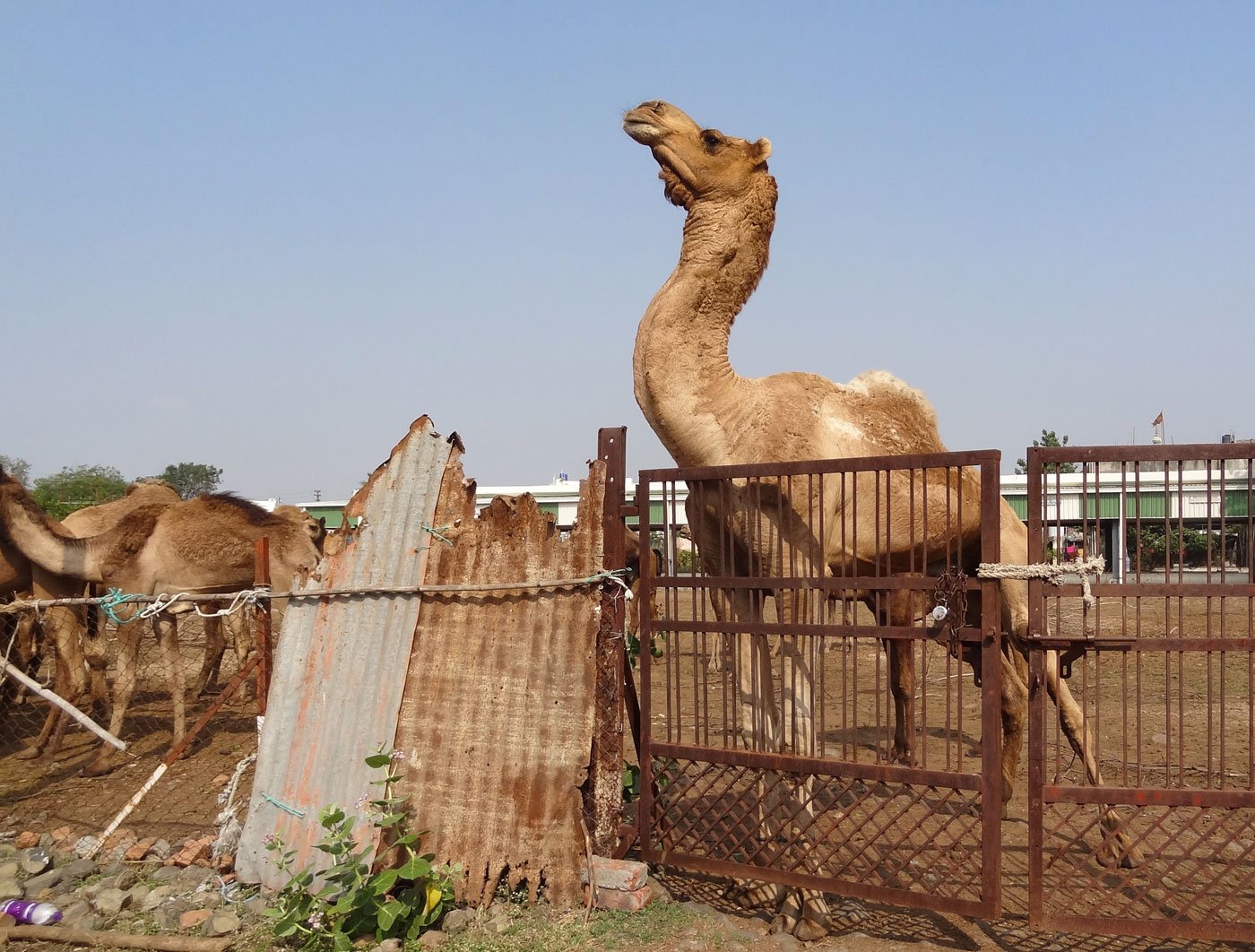
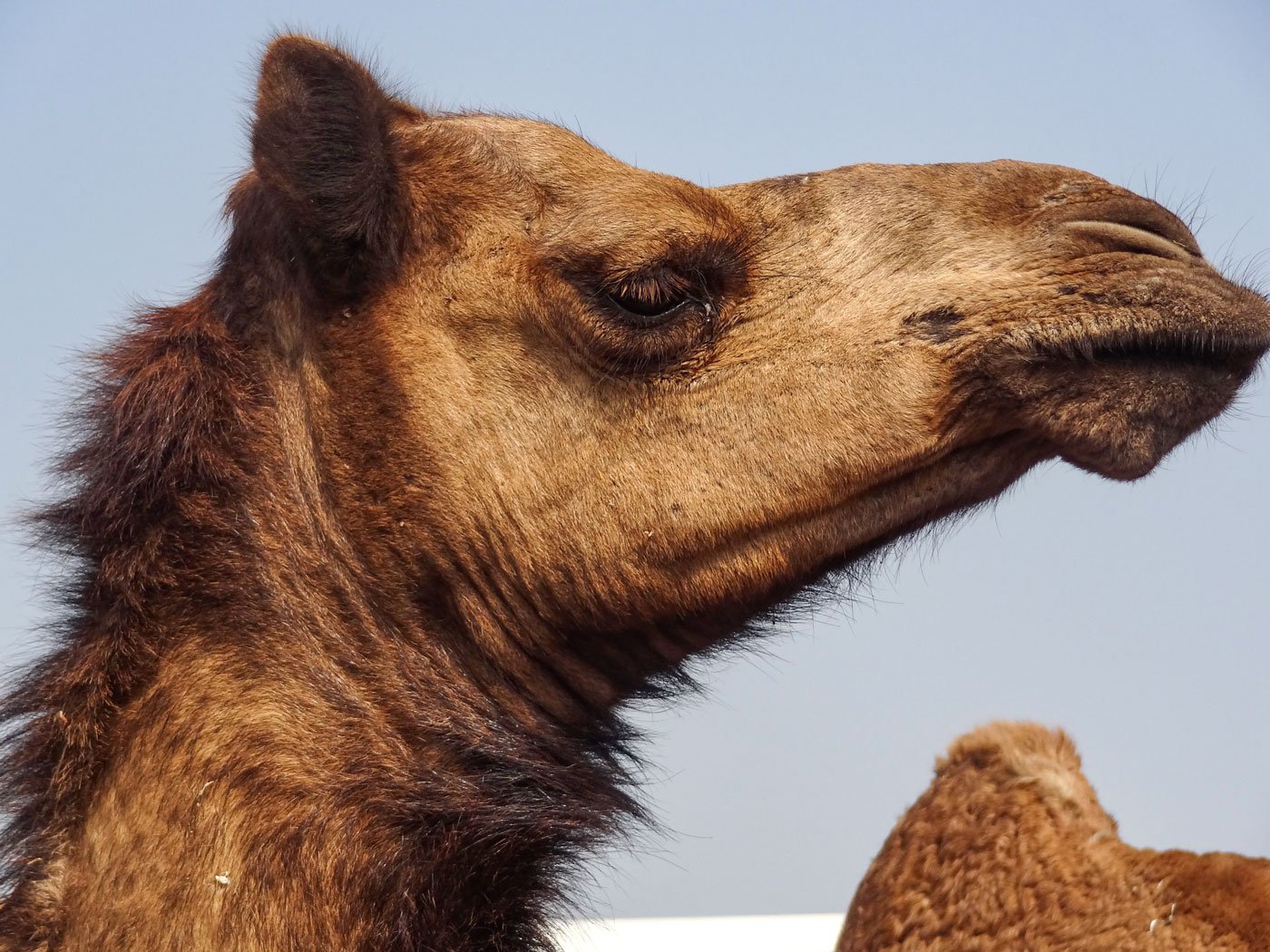
A narrow chest, single hump, and a long, curved neck, as well as long hairs on the hump, shoulders and throat are the characteristic features of the Kachchhi breed
It is also not true, the Rabaris say, that camels can’t acclimatise to or live in regions away from Kachchh (or Rajasthan). “They have been living and roaming all over the country with us for ages,” says Asabhai Jesa, an experienced Rabari camel keeper who lives in Asgaon in Bhandara district’s Pauni block.
“It is an irony,” says Parbat Rabari, another veteran migrant herder who has settled in a village near Nagpur’s Umred town. “The charge against us is that we treated them cruelly. But there is no greater cruelty than keeping them confined here when they need open grazing.”
“Camels do not eat what cattle do,” says Jakara Rabari who lives in a village called Sirsi in Nagpur district’s Umred taluka . Jakarabhai was to get three camels from this lot.
Kachchhi camels feed on a vast variety of plant and leaf species – neem , babul , peepal , among other varieties. In Kachchh, they graze on trees and fodder native to the drier and hillier regions of the district, which contributes to the remarkably high nutritive value of their milk. A female camel of this breed normally produces 3-4 litres of milk a day. Kachchhi herders try and bring their camels to water every alternate day. Typically, these animals consume 70-80 litres at one time – within 15 to 20 minutes when thirsty. But they are capable of lasting out without water for much longer periods.
None of the 58 camels at the gauraksha kendra has ever been used to a confined system of feeding. And while the older animals do eat the groundnut residues they find here, the younger ones haven’t yet been exposed to such fodder, says Parbat Rabari. Along their way to this place in Amravati, he says, they had been consuming the leaves of roadside or farm trees.
A young male camel, Parbat informs us, eats up to 30 kilos of fodder a day.
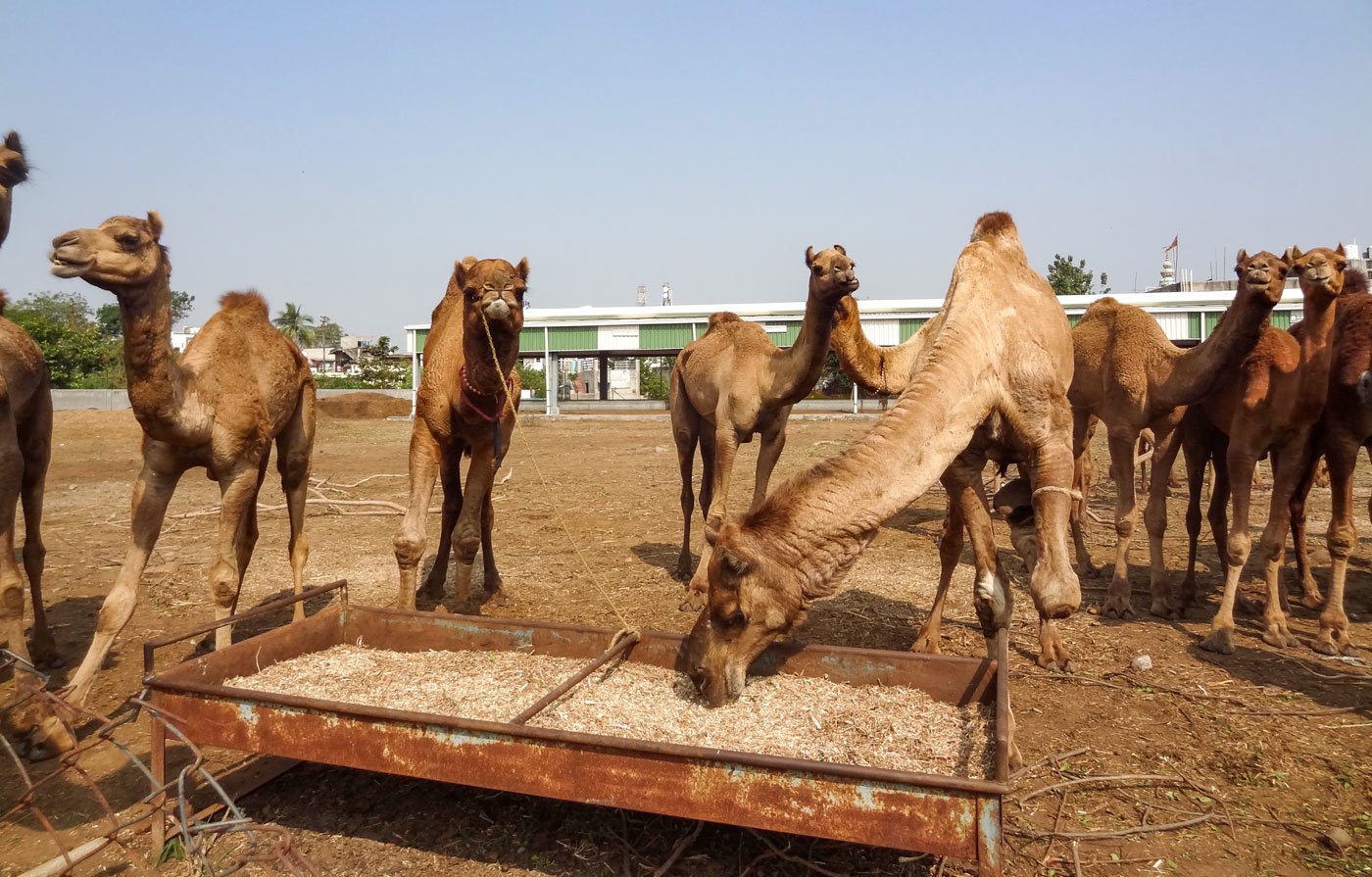
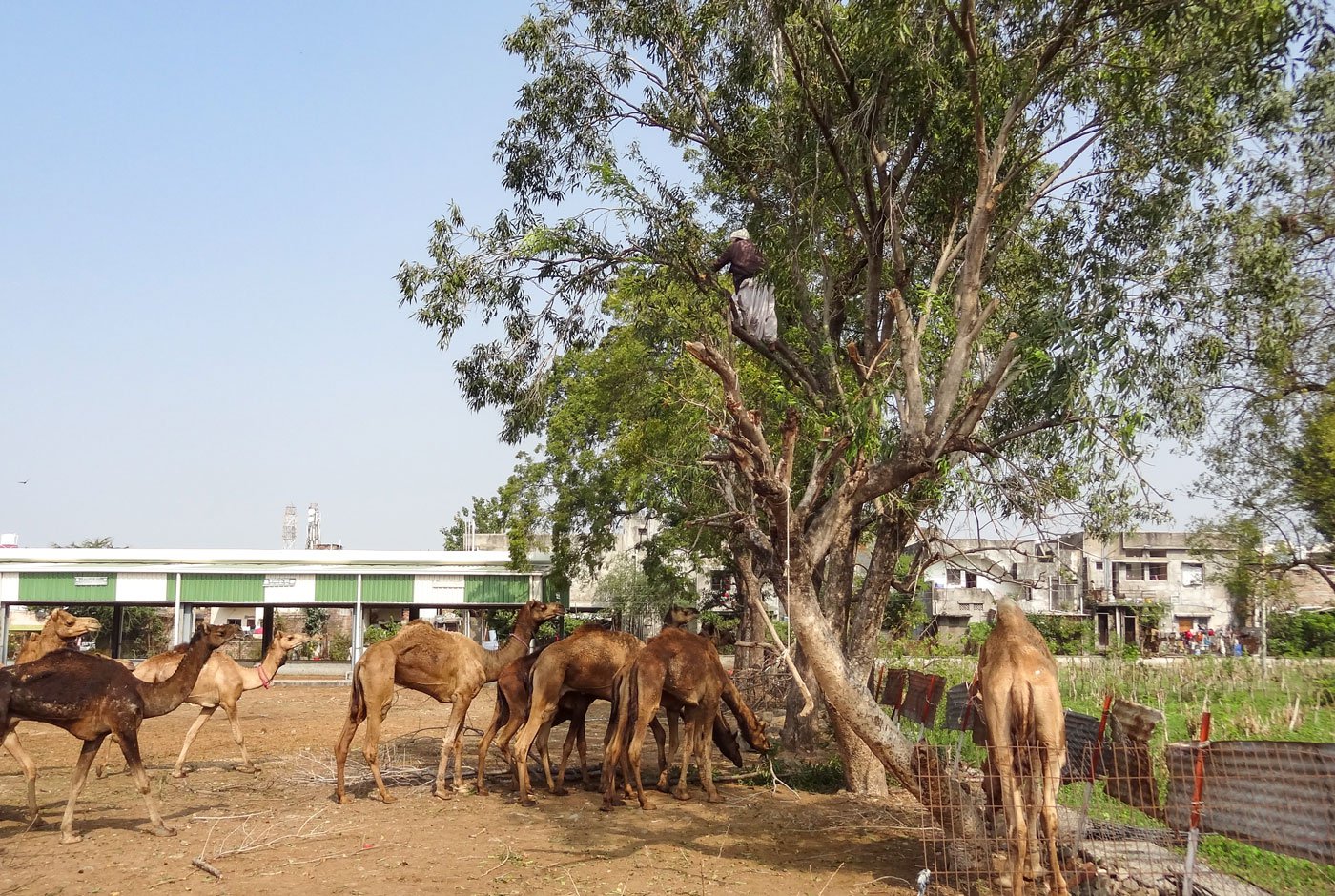
Left: Eating cattle fodder at the cow shelter. Right
: A Rabari climbs a
neem
tree on the premises to cut its branches for leaves, to feed the captive camels
The shelter here feeds its cattle with all sorts of crop residues – of soybean, wheat, jowar , maize, minor and major millets, and even green grasses. And these are what are now on offer to the detained camels.
Parbat, Jakara, and a dozen other Rabaris settled in Maharashtra and Chhattisgarh for many decades now, rushed to Amravati when they learned about the detention of their men and camels. They have been keeping an anxious eye on the animals.
“Not all the camels were tied up; but some of them need to be, otherwise they will bite each other or trouble passers-by,” says Jakara Rabari, currently camping at the gauraksha kendra , waiting for the court to decide on their custody. “These young males can get very aggressive,” he says.
The Rabaris insist the camels need to be released for open grazing. There have been instances in the past when camels detained by police have died in confinement.
A plea to this effect is being moved before the lower court by their local lawyer, Advocate Manoj Kalla, for granting of custody of the camels back to the Rabaris as early as possible. Their kinfolk in Kachchh, local members of the community, and the buyers coming in from different places – have all pooled their resources to help fight the case, pay for the lawyers, their own stay, and in trying to reach the correct fodder to the animals.
Meanwhile, the cow shelter has custody of the camels.
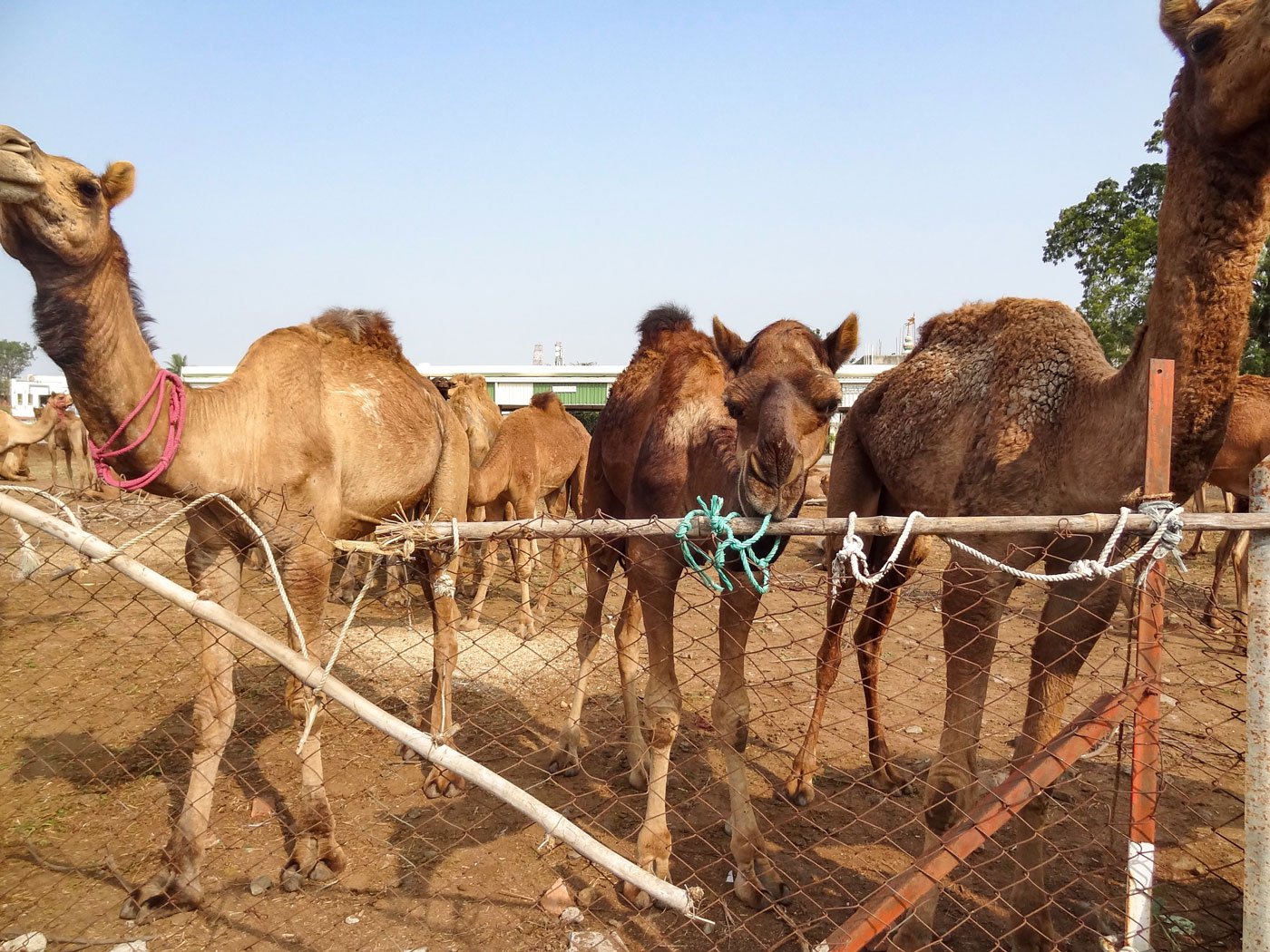
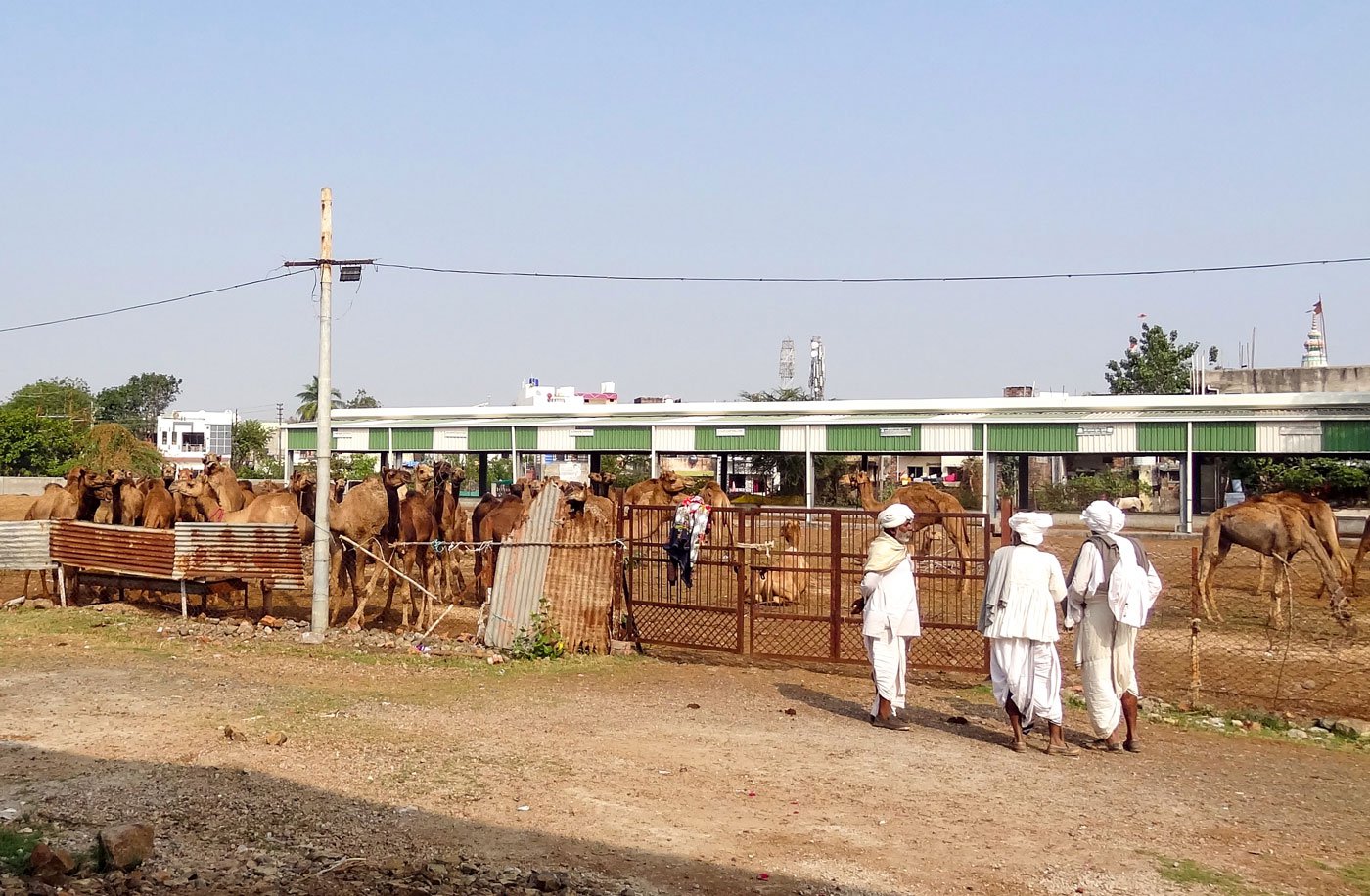
The 58
dromedaries have been kept in the open, in a large ground that's fenced all around. The Rabaris are worried about their well-being if the case drags on
“Initially we had problems in feeding them, but now we know how much and what kind of fodder to give them – the Rabaris are also helping us with that,” says Deepak Mantri, secretary of Gaurakshan Samiti, Amravati, which runs the cattle shelter. “We have 300 acres of farmland nearby, from where we bring green and dry foliage for the camels. “There is no shortage of fodder for them,” he claims. An inhouse team of veterinary doctors came and treated the camels that had some injuries. “There’s no problem for us in looking after them here,” he insists.
“The camels are not eating well,” says Parbat Rabari, who hopes the court will end their confinement and hand them back to their owners. “This is like a jail for them,” he says.
Out on bail now, Versibhai and the four other men are anxious to go home, but only with their animals released and returned to them. “On Friday, January 21, the judicial magistrate at Dhamangaon (lower court) asked the five herders to produce documents to prove their ownership of the 58 camels," Manoj Kalla, the lawyer representing the Rabaris, told PARI. "It could be receipts issued by the people they claim to have bought the animals from."
Meanwhile, the Rabaris waiting to regain custody of these camels are also camping at the cattle shelter in Amravati along with their kinfolk and the camel buyers. All eyes are on the Dhamangaon court.
The camels remain, uncomprehending, in detention.
